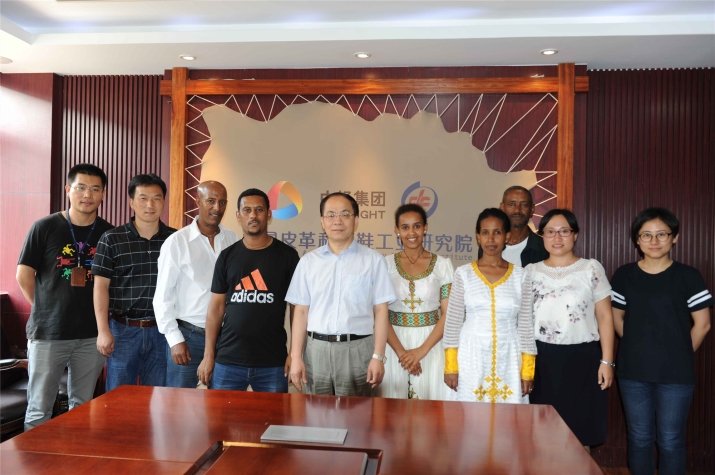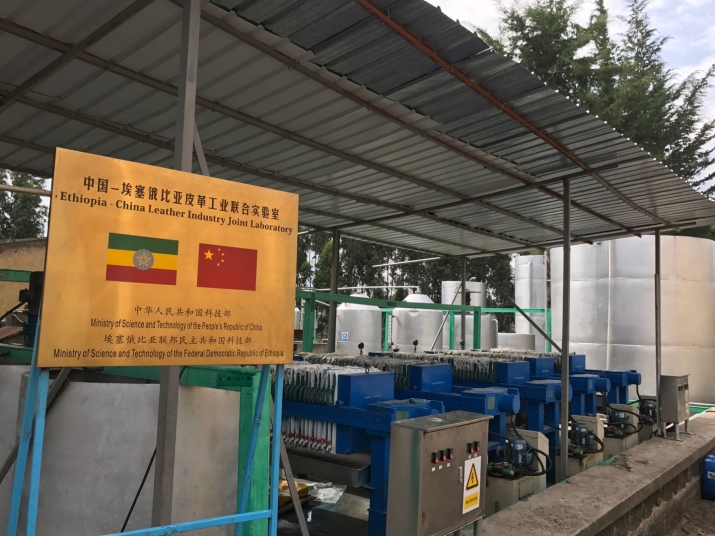|
||||||||||
| Home Nation World Business Opinion Lifestyle ChinAfrica Multimedia Columnists Documents Special Reports |
|
||||||||||
| Home Nation World Business Opinion Lifestyle ChinAfrica Multimedia Columnists Documents Special Reports |
| ChinAfrica |
| No Time to Waste |
| China's leather waste recycling and utilization technology helps Ethiopia clean up its tanneries |
| By Xia Yuanyuan | VOL.11 May ·2019-05-13 |

Some of the trainees of the Ethiopia-China Leather Industry Joint Laboratory (COURTESY PHOTO)
Located some 80 km from Ethiopia's capital Addis Ababa, the Modjo River is an important water source for the country's many inhabitants. Paradoxically, it is also one of the most polluted rivers in the country. A major pollutant in the river is industrial waste, containing high levels of chromium emanating from leather manufacturing companies found in the area.
Bringing this industry in line with green development has been a big challenge for Ethiopia. In December 2013, under the Belt and Road Initiative, the China Leather and Footwear Research Institute (CLFI) of Sinolight Co. Ltd. and the Leather Industry Development Institute (LIDI) of Ethiopia jointly set up the Ethiopia-China Leather Industry Joint Laboratory, which aims to strengthen bilateral cooperation in cleaner leather production technology and waste recycling and utilization.
Now, the laboratory is playing a leading role in improving the nation's tanning production technology and leather solid waste treatment technology. It is committed to providing strong technological support for the local leather industry to reduce pollutant emissions and achieve sustainable development in the near future, according to insiders.
Sustainable development
Ethiopia is home to the largest population of livestock in Africa, including millions of cattle, sheep, goats and camels. This has meant that the leather industry is one of the fastest growing sectors in Ethiopia. In recent years, the country has attracted increasing foreign investment in the leather manufacturing sector. For example, in 2012, Chinese footwear manufacturer Huajian Group established a factory at the Eastern Industry Zone near Addis Ababa where it manufactures thousands of pairs of shoes and boots daily. Statistics from LIDI show that Ethiopia earned $115.4 million in 2016 from the export of leather and leather products - around 30 percent of the country's total export earnings.
In addition to this sizeable economic contribution, the leather sector in Ethiopia has also created jobs for tens of thousands of people, ranging from cottage industry shoemakers to big tanneries and leather product manufacturers.
However, along with the leather processing industries, waste generation also inevitably exists. Though Ethiopia has the potential for supplying skins and hides to the world market, the backwardness in production technology is a stumbling block for the sustainable development of the industry.
Tanneries are generally pollution-intensive industrial complexes generating large volumes and a high concentration of liquid and solid wastes. If these solid wastes produced during various tanning processes are not properly utilized or disposed of, they are very likely to cause a number of environmental problems as well as affect human health.
Therefore, there is a dire need for the country to improve its waste management systems in the leather processing industry to mitigate the problems of pollution.
China is well placed to assist with this as it leads the world in the field of clean tanning production technology and solid waste resource utilization technology.
The cooperation between China and Ethiopia in leather waste processing can be traced back to 2013 when the two countries marked the 10th anniversary of the establishment of the comprehensive cooperative partnership. In November that year, the Chinese Ministry of Science and Technology and the Ethiopian Ministry of Science and Technology signed a memorandum of understanding (MoU) on the establishment of a joint leather laboratory at Ethiopia. Guided by the MoU, LIDI and the CLFI began their cooperation in tannery waste management in December 2013 when CLFI delegates visited Ethiopia and met with LIDI's management.

Hith technology is used at Ethiopia-China Leather Industry Joint Laboratory (COURTESY PHOTO)
Leading technology
The chrome tanning process is an important part of the leather maunfacturing, making leather products soft and of high quality. However, in the production process, 25 percent of the chromium is not absorbed, and eventually becomes chrome shavings, sewage and sludge containing a large amount of heavy metal chromium. Between 2013 and 2017, China assisted Ethiopia with equipment and technologies, including clean production technology and solid waste management such as the technologies of extracting collagen protein from chrome shavings and waste water treatment. Professionals and experts from China were sent to conduct trainings in the laboratory.
For instance, recycling technology of chrome waste water, a patented technology owned by China, could not only filter solid impurities in the chrome tanning waste liquid, but also reuse the recovered chrome tanning agent. In the tanning process of leather production, 99.9 percent of chrome tanning agent in waste liquid can be recovered, according to Professor Ding Zhiwen, head of the project and Vice President of the CLFI.
"The new technology can save more than 25 percent of chromium compared with the traditional chrome tanning process. The amount of the tanning agent and the use of water are reduced by over 95 percent, which helps eliminate the problem of chromium salt pollution in the tanning process and brings tanning water up to the discharge standards," he said.
According to estimates, if the technology is used in all the tanneries in Ethiopia, it can reduce heavy metal emissions by more than 99 percent, and reduce the ratio of chrome tanning agent by 25 percent. Annual savings of chrome tanning agent and wastewater treatment could amount to more than $3 million.
Apart from reducing pollution, China's liming and chrome waste water recycling technology and pilot-scale equipment also help change waste into valuable materials.
"China's technology and the integrated wastewater treatment equipment could extract the chrome tanning agent from waste chrome liquid, which could be reused in leather manufacturing, and other solid waste such as sludge can also be used for incineration for power generation," said Zerfie Mersha, Director of Environmental Technology Directorate of LIDI.
Personnal training
During the implementation of the project, a total of 76 Ethiopians have been trained on new technologies and use of new equipment .
One of them is Chernet Yonas Kebede. He began as a worker and is now a technician responsible for leather waste recycling work.
"My monthly salary has increased from less than 2,000 birr ($74) to 4,500 birr ($167)," said Kebede. He is grateful to have the opportunity to learn advanced technology and skills in the leather field. "With systematic training, I am now responsible for the operation of the leather wastewater treatment facilities. This is very rewarding for an ordinary worker who wants to work independently to support a family of four and also has a mortgage," he said.
Ato Berhanu Negus, Product and Productivity Sector Coordinator of LIDI, said the joint laboratory has introduced new technologies and cultivated a group of fresh talent. According to him, the partnership between the two institutes is further increasing mutual benefits between China and Ethiopia in the leather sector.
Looking ahead, China and Ethiopia will further cooperate in sustainable development of the leather industry and smart manufacturing, said Pang Xiaoyan, Senior Engineer of CLFI.
Mersha said that in the short term, LIDI is planning to build a leather solid waste utilization treatment plant with a daily processing capacity of 30-50 tons in Ethiopia.
(Comments to niyanshuo@chinafrica.cn)
|
||||||||||||
| About Us | Contact Us | Advertise with Us | Subscribe |
| Copyright Beijing Review All rights reserved 京ICP备08005356号-5 京公网安备110102005860号 |